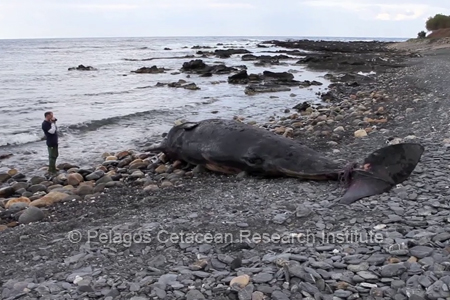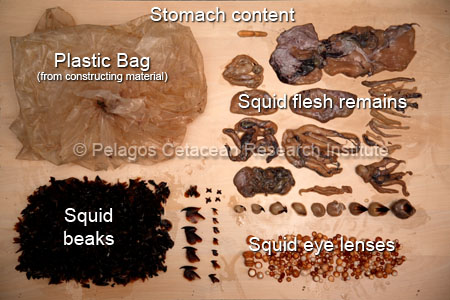
If the video does not work through the above link,
click here |
|
SPERM WHALES OF GREECE:
LIFE IN THE TRENCHES
A brief and comprehensive documentary that describes thoroughly how field research on sperm whales is conducted in the Greek Seas. In parallel, it gives a good idea of many features of the sperm whale life and biology (echo-location system, communication, social groups, deep dives, etc), as well as the dangers threatening their small and fragile population.
Production: EarthOCEAN 2007 (Chris Johnson, Genevieve Johnson)
Time lenght: 17:32"
|
| |
|
|
|
|
|
SPERM WHALE:
THE KIND GIANT OF GREEK SEAS
The first Greek documentary on the sperm whales of the Greek Seas, containing wonderful underwater shots. It is the outcome of an encounter between the Hellenic Center of Marine Research and the Pelagos Cetacean Research Institute. It covers most of the topics about sperm whale biology, research methods in the open sea and finally the goals of the research program aiming at their conservation.
Production: Olyvon, SKAI TV, CYTA 2011
Total time length: 31:27"
|
| |
|
|
|
|
BRIEF DESCRIPTION OF THE RESEARCH PROGRAM "SPERM WHALES OF GREEK SEAS"
In this video, we explain the reasons which make this research program of major importance for the Pelagos Institute. The scientific methods we use, as well as the results of our research are presented. Finally, the research aims of the program, as well as the environmental goals regarding the conservation of sperm whale population are analyzed.
Production: Olyvon, SKAI TV, CYTA 2011
Time length: 3:58" |
| |
|
|
|
|
Supplementary videos shots and topics from
"SPERM WHALE: THE KIND GIANT OF GREEK SEAS"
Short video about the sight of sperm whales, their hearing and the way the noise pollution caused by boats, exterminates their population through hearing loss and subsequently the increase of fatal sperm whale-ship collisions.
Production: Olyvon, SKAI TV, CYTA 2011
Time length: 3:42"
|
| |
|
|
|
|
Supplementary video shots and topics from "SPERM WHALE: THE KIND GIANT OF GREEK SEAS"
More beautiful underwater video shots from sperm whale social units during socializing.
Production:Olyvon, SKΑΙ TV, CYTA 2011
Time length: 2:51"
|
| |
|
|
|
|
|
DOLPHINS OF GREECE
Dolphin bservations during an expedition with the research vessel "NEREIS" in the Ionian Sea, gave us the opportunity to describe here, elements of the behavior of different species of dolphins. In a second expediton in the National Park of North Sporades with the Hellenic Center of Marine Research and their big oceanographic vessel “Aegaeo”, researchers meet the nowadays rare “common dolphins” and the Mediterranean monk seal, and discuss about the problems of their conservation.
Production: Olyvon, SKAI TV, CYTA 2011
Total time length: 30:07"
|
| |
|
|
|
|
THE 4 SPECIES OF DOLPHINS AND THE REASONS OF EXTINCTION OF THE COMMON DOLPHIN
In the first part of this interview, the 4 species of dolphins with permanent populations in the Greek Seas (and in the National Park of North Sporades) and their ecological and alimentary habits are described. In the second part, it is explained how one of these dolphin species, the “common dolphin”, became rare due to overfishing and depletion of its food stocks by humans.
Production: Olyvon, SKAI TV, CYTA 2011
Time length 6:36" |
| |
|
|
|
|
PROBLEMS IN DOLPHIN CONSERVATION AND THE IMPORTANCE OF RESEARCH
Full analysis of the problems of extinction of species (particularly of the common dolphin) and their solutions. The problem of overfishing, as well as dolphin conservation methods, which would bring important profits to local societies, are described. The importance of scientific research (disregarded in our country) is highlighted, as the only way to define and propose substantiated solutions for conservation, which could then be applied only through the pressure of society on governments and decision makers.
Production: Olyvon, SKAI TV, CYTA 2011
Time length 8:07" |
| |
|
|

 |
|
THE INGLORIOUS END OF A SPERM WHALE
Video containing graphic images of one (among the many) necropsies performed by the Pelagos Cetacean Research Institute in Greece, on stranded cetaceans. Dead cetaceans are "scientific treasures" because they provide very important knowledge and information about the conservation of these animals, which cannot be collected in another way than necropsies. The goal of a necropsy is to identify the causes of death, which constitute potential threats for the species, and to collect data concerning cetacean feeding habits (stomach content), biology (development-age), genetics and morphology (skeletal remains). Necropsies, except from being unpleasant, are also very difficult to conduct, especially in large cetaceans. This particular 8-meter long female sperm whale in this movie, died after being entangled in ropes of fishing longlines close to Crete. However, in her stomach we found a big plastic bag that escaped from some human hand… Plastic bags found in dolphin and sperm whale stomachs, is now a very common event that sometimes leads to death (stomach obstruction and starving), preceded by horrible pain.
Production: Pelagos Cetacean Research Institute 2011
Camera-Editing : Natalia Tsoukala
Time length 8.39" |